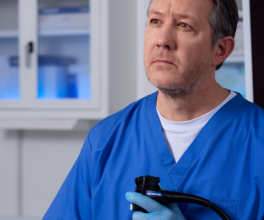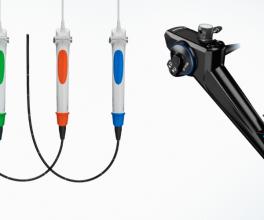
White Paper Takes Deeper Dive on Role of Single-use Bronchoscopes
Superbugs and hospital acquired infections had already shined a scrutinizing light on reprocessing practices following endoscopic procedures. In the field of pulmonology, the COVID-19 pandemic heightened fears over bronchoscopy, given the respiratory symptoms associated with COVID-19, fears of virus transmission, and ineffective endoscope reprocessing. But was the push to replace reusable flexible bronchoscopes (RFBs) with single-use flexible bronchoscopes (SUFBs) too aggressive? A recently published white paper from Olympus takes a closer look.
Context
Pulmonologists have relied on RFBs for decades for diagnostic and therapeutic indications for lung disorders, according to Septimiu Dan Murgu, MD, FCCP, DAABIP, Interventional Pulmonologist, Critical Care Physician, and Professor of Medicine at The University of Chicago Medicine. Over the years, advanced optics and enhanced maneuverability have made numerous complex procedures possible. But a little over a decade ago, the field saw the emergence of a single-use device to eliminate reprocessing requirements, among other purported benefits.
The push for disposables
In “Evaluating Reusable Versus Single-use Bronchoscopes: A perspective on their unique roles in ICUs, ORs and bronchoscopy suites during COVID-19 and beyond,” Dr. Murgu notes that these single-use devices have been used primarily by anesthesiologists in the ICU or perioperative setting.
But COVID-19 may have moved the needle. According to Dr. Murgu, various professional pulmonary societies responded to COVID-19 transmission and reprocessing fears by suggesting a more prominent role in the use of SUFBs, especially in patients with known or suspected COVID-19.
“Most of these early recommendations were made with expert opinion derived from the belief that fomite transmission of SARS-CoV-2 may be reduced by using SUFBs”
Killing bugs
As it turns out, Dr. Murgu indicates that coronaviruses are easy to kill with high-level disinfectants or sterilization cycles as part of standard reprocessing practices. In the paper, he explains the hierarchy of microorganisms and their susceptibility to high-level disinfection. “It is noteworthy to recognize that the transmission and pathogenicity of microorganisms do not equate to their susceptibility to disinfectants,” he writes. Thus, the move to SUFBs should not be based on the “highly transmissible” argument, provided existing reprocessing protocols are followed.
Weighing risks and benefits
Dr. Murgu looks at the purported benefits of SUFBs—portability, cost, and time efficiency—to fill in the urgent care gap, citing survey data and literature worth a closer review in determining SUFBs true utility. This is weighed against the limited technology he discusses in the paper and less advanced imaging capabilities of SUFBs. Nonetheless, “each offers advantages in specific procedural settings.”

To read more about the unique roles of RFBs and SUFBs in their respective procedural settings, complete the below form to download “Evaluating Reusable Versus Single-use Bronchoscopes: A perspective on their unique roles in ICUs, ORs and bronchoscopy suites during COVID-19 and beyond.”
Dr. Murgu is a paid consultant to Olympus Corporation of the Americas, which underwrote the production costs for this white paper.
All quotes taken directly from featured white paper, Evaluating Reusable Versus Single-use Bronchoscopes: A perspective on their unique roles in ICUs, ORs, and bronchoscopy suites during COVID-19 and beyond (2021) by Dr. Septimiu Dan Murgu.





